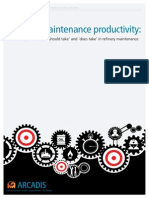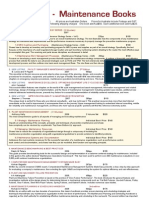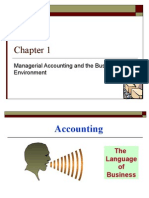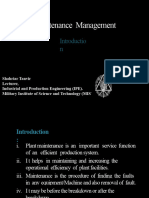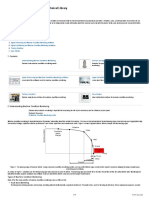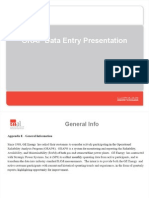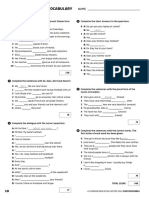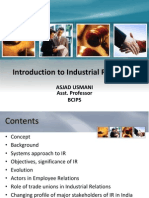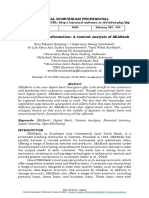Max Plant Ace
Max Plant Ace
Uploaded by
Naviin AgrawalCopyright:
Available Formats
Max Plant Ace
Max Plant Ace
Uploaded by
Naviin AgrawalOriginal Title
Copyright
Available Formats
Share this document
Did you find this document useful?
Is this content inappropriate?
Copyright:
Available Formats
Max Plant Ace
Max Plant Ace
Uploaded by
Naviin AgrawalCopyright:
Available Formats
Maximizing Maintenance Operations for Profit Optimization:
The Journey to Maintenance Excellence
February 2002
Establishing a Strategy for Profit-Centered Maintenance
By
The Maintenance Excellence Institute
____________________________________________________________
Division of Ralph W. Peters and PEOPLE Inc.
The Maintenance Excellence Institute Maximizing Maintenance Operations for Profit Optimization Page 2
Part IV: Path Forward to a Profit-Centered Maintenance Operation
Ralph W. Pete Peters The Maintenance Excellence Institute Division of Ralph W. Peters and PEOPLE Inc. 6809 Foxfire Place, Suite 100 Raleigh, North Carolina 27615 919-846-6019 RalphPetePeters@aol.com
http://www.PRIDE-in-Maintenance.com Introduction: Part IV provides a recommended strategy used successfully by The Maintenance Excellence Institute for manufacturing maintenance operations, as well as operations in both the public and private sectors including pure facilities maintenance operations, healthcare maintenance and even major contract maintenance providers where in house maintenance has been contracted out or privatized. This part defines three key elements that help turn improvement opportunities into visible profit-centered results. These elements all contribute directly to profit optimization and include how to: 1. Determine and quantify benefits and savings 2. Improve craft productivity, the most valuable resource 3. Define a path forward strategy to implement improvement opportunities This section summarizes the many direct and indirect savings opportunities and illustrates how one of those opportunities; increased craft productivity can be included as gained value. It shows how just one of many best practice areas from The Scoreboard for Maintenance Excellence; effective shop level planning and scheduling provides more than a 5 to 1 return on the investment for just one planner position for a 20 person craft work force. When maintenance becomes truly profit-centered, ranging from attitudes to actions, the profit optimization process has another very real element to include in the final tally. Determine and Quantify Benefits and Savings: Potential savings (both tangible and intangible) must be estimated and established at their most realistic levels. Maintenance must be given the best practice tools, the people resources, and capital investments to address the improvement opportunities and in turn are held accountable for results. There are a number of key areas where direct savings, cost avoidances and gained value can be established, documented. a. Gained value from increased craft labor utilization/effectiveness due to increases in wrench time b. Gained value from increased craft labor performance/efficiency c. Gained value of clerical time reductions for supervisors, planners, engineering and admin staff d. Value of asset/equipment uptime e. Value of facility availability or cost avoidance from be non-available f. Value of MRO materials and parts inventory reduction g. Value of overall MRO materials management improvement h. Value of overall maintenance costs reductions with equal or greater service levels i. Value of increased facility and equipment life and net life cycle cost reduction j. Value of increased direct labor utilization (production operations) k. Value of operations productivity increases (production operation) ____________________________________________________________
Ralph W. Peters and PEOPLE Inc.
The Maintenance Excellence Institute Maximizing Maintenance Operations for Profit Optimization Page 3
Craft Productivity: Lets look at one example related to craft productivity. Surveys consistently show that wrench time (craft utilization) within a reactive, fire fighting maintenance environment is within the range of 30 to 40 percent. This means that for a ten hour day there is only four hours of actual hands-on, wrench time. Typically, low craft utilization is due to no fault of the craft work force. Most of the lost craft labor productivity can be attributed to the following reasons: 1. 2. 3. 4. 5. 6. 7. 8. 9. Running from emergency to emergency; a reactive, fire fighting operation Waiting on parts and finding parts or part information Waiting on other information, drawings, instructions, etc. Waiting for the equipment to be shut down Waiting on rental equipment to arrive Waiting on other crafts to finish their part of the job Travel to/from job site Lack of effective planning and scheduling Make-ready, put away, clean up, meetings, troubleshooting, etc.
The Most Valuable Resource: Maintenance operations that continue to operate in a reactive, run-tofailure, fire fighting mode and disregard implementation of todays best practices will continue to waste their most valuable asset and very costly technical resource - craft time. Best practices such as effective maintenance planning/scheduling, preventive/predictive maintenance, more effective storerooms and parts support all contribute to proactive, planned maintenance and more productive hands on, wrench time. An improvement in actual wrench time from 40% to 50% represents a 25% net gain in craft time available and a significant gained value. When we are able to combine gains in wrench time with increased craft performance when doing the job we increase our total gain in craft productivity. Measuring and improving overall craft productivity can be a key component to justify an effective CMMS and other investments for maintenance improvement. Gained Value of 10% in Wrench Time: What if through better planning and scheduling, good parts availability and having equipment available to fix it on a scheduled basis, we are able to increase actual wrench time by 10 percent? What is the value to us if we get that 10 percent increase across the board for a 20- person crew operating now at 40% wrench time being paid an average hourly rate of $18 per hour. Total Craft Hours Available and Annual Craft Labor Costs Hrs. wk.
20 Crafts x 40
x 52 wks./yr. = 41,600 Craft Hours Available
41,600 Craft Hours @ $18/hr. = $748,800 Craft Labor Cost/Year
____________________________________________________________
Ralph W. Peters and PEOPLE Inc.
The Maintenance Excellence Institute Maximizing Maintenance Operations for Profit Optimization Page 4
Wrench Time and Actual Costs Per Hour at Various Levels of Craft Utilization Average Wrench Time Hours Per Craft Position 624 832 1040 1248 1456 1664 1768 1872 2080
Level of Craft Utilization 30% 40% 50% 60% 70% *80% *85% 90% 100%
Total Wrench Time (Hours) 12,480 16,640 20,800 24,960 29,120 49,920 35,360 37,440 41,600
Actual Hands On Cost Per Hour $60.00 $45.00 $36.00 $30.00 $25.71 $22.50 $21.18 $20.00 $18.00
Note: Maximum possible craft utilization is 80 to 85 percent considering paid holidays, vacation time, breaks, clean-up, employees meetings, craft training, etc. See Figure IV-1 For Example: With effective planning and scheduling we can achieve at a minimum a 10 point improvement in craft utilization. From a baseline of 40 percent up to a level of 50 percent we in effect get a 25 percent increase in craft capacity for actual work. Total Hours Gained in Wrench Time: 4,160 hours gained 20,800 hours @ 50% - 16,640 hours @40% = 4,160 hours gained Total Gain in Equivalent Number of Crafts Positions: 5
4,160 Hours Gained 832 Average Wrench Time Hours @ 40%
= 5 Equivalent Craft Positions
Total Gained Value of 5 Equivalent Positions: $280,800 hrs. wk. Wks $18.00 yr. x hr.
5 equivalents x 40
x 52
= $187,200 Gained Value
Valuable Craft Time Can Slip Away: With only a 10% improvement up to 50% wrench time, the 20person craft work force operating at 40 percent craft utilization baseline, the 4,160 hours of wrench time gained represents a 25 percent increase in craft labor capacity. The maintenance best practice for planning and scheduling requires dedicated a planner(s). An effective maintenance planner in turn can support and plan for 20 to 30 crafts positions. With only a 10 percent increase in craft utilization for a 20-person craft work force, can be much more than a 5 to 1 return to offset a maintenance planner position. Figure IV-1 on the next page illustrates How Your Valuable Craft Time Can Slip Away. ____________________________________________________________
Ralph W. Peters and PEOPLE Inc.
The Maintenance Excellence Institute Maximizing Maintenance Operations for Profit Optimization Page 5
Figure IV-1
How Your Valuable Craft Time Can Slip Away
Total Available Days: 52 Weeks/Yr x 5 Days/Week = 260 Available Days Maximum Without Overtime 260 Total Days 10 Days Holiday Per Year = 250 Days Now Available
250 Days/Yr 15 Vacation/Sick Days Average Per Year = 235 Days Now Available 235 Days/Yr 15 Days Break Time* Per Year = 220 Days/Year Now Available Bottom Line: 220 days 260 days = .846 = 85% +/Craft Time Available for Work Various Levels of Wrench Time 85% 70% 60% 50% 40% 30% 20% 10% = = = = = = = = Maximum Craft Utilization World-Class Wrench Time Very Good Wrench Time Good Wrench Time Above Average Wrench Time Average Wrench Time On Call: The Maytag Repairman On Call: The Maytag Repairman
Note*: 15 min x 2 breaks/day = hour/day x 235 days =117.5 hours 8 hours/day =15 Total days Per Year
____________________________________________________________
Ralph W. Peters and PEOPLE Inc.
The Maintenance Excellence Institute Maximizing Maintenance Operations for Profit Optimization Page 6
The planner(s) position is normally recruited internally and not replaced. The additional craft capacity and productive craft time that is gained can be used to: ! Accomplish deferred repairs ! Accomplish PMs being neglected ! Reduce overtime ! Accomplish work done by contractors ! Reduce need to add or replace staff
Develop and Implement Strategic Action Plan: Successful implementation of maintenance best practices is the objective and represents the culmination of doing an effective overall evaluation and having a well-defined plan of action developed from recommendation that evolve from it. The results from the evaluation sets the stage for a prioritized plan of action. A project team is then defined and a more detailed project plan with tactical and operational tasks/plans to support strategic plan implementation. The major phases of a strategic plan of action may look something like the following: Phase I: Establish Strategic Plan of Action Evaluate and Select CMMS CMMS Implementation Best Practice Development and Implementation Planning Phase II: Phase III: Phase IV: Phase V: Phase VI: Phase VII: Initiate Effective Planning and Scheduling MRO Materials Management and Procurement Improvements Storeroom Modernization More Effective Preventive and Predictive Maintenance Technology
Develop and Establish Maintenance Planning Function Evaluate, Select and Implement CMMS Develop and Implement Storeroom Modernization, MRO Improvements Implement Other Maintenance Best Practices Measure Maintenance Performance and Validate Benefits with Maintenance Excellence Index (MEI in Part V) Continuous Maintenance Improvement
The Real Work is Implementation: Successful implementation is the ultimate objective that provides maximum value to your maintenance operation. It is very important to remember the 90-10 Rule for projects. Ninety percent of the real project work comes during the implementation and normally the easiest part is planning which is only ten percent of the work. Never underestimate the resources needed for implementation. Begin implementation with clearly defined plans for each area of the strategic plan as well as tactical and operational level tasks and actions. Never begin implementation without methods in place to validate results especially if you use external consulting resources. External resources at times might borrow your watch to tell you the time and then walk off with your watch before implementation. ____________________________________________________________
Ralph W. Peters and PEOPLE Inc.
The Maintenance Excellence Institute Maximizing Maintenance Operations for Profit Optimization Page 7
Profit Optimization is About Total Operations Success and Profit: Part IV has provides a recommended strategy used successfully for manufacturing maintenance operations, as well as operations in both the public and private sectors and even for major contract maintenance providers. It has looked at three key elements that help turn improvement opportunities into visible profit-centered results and support to profit optimization and include how to: 1. Determine and quantify benefits and savings 2. Improve craft productivity, the most valuable resource 3. Define a path forward strategy to implement improvement opportunities There are many direct and indirect savings opportunities and we illustrated how to capture one of those opportunities; increased craft productivity as gained value. Just one of many best practice areas from The Scoreboard for Maintenance Excellence; effective shop level planning and scheduling by a single planner can provides more than a 5 to 1 return on the investment for a 20 person craft work force. When maintenance becomes truly profit-centered, ranging from attitudes to actions, the profit optimization process has another very real element to include in the final tally for the total operation. You Can Get Maximum Value from Your Maintenance Operation: You can maximize your total maintenance operation for profit optimization by successful implementation of strategic, tactical and operation level actions. To find out the best approach for your organization, for help with planning the pilot evaluation and to receive a complete copy of this five-part series contact. Ralph Pete Peters The Maintenance Excellence Institute 6809 Foxfire Place, Suite 100 Raleigh, NC 27615 E-Mail: RalphPetePeters@aol.com Office: 919-846-6019 Fax: 919-846-9804 http://www.PRIDE-in-Maintenance.com
____________________________________________________________
Ralph W. Peters and PEOPLE Inc.
The Maintenance Excellence Institute Maximizing Maintenance Operations for Profit Optimization Page 8
Bio of Ralph W. Pete Peters
President and founder for Ralph W. Peters and PEOPLE Inc. a consulting firm with three divisions for total operations improvement; The Maintenance Excellence Institute (maintenance), The Manufacturing Excellence Institute (manufacturing) and The Institute for Public Service Excellence (governmental). His practical engineering experience and technical leadership in the maintenance, manufacturing and governmental productivity consulting fields has helped hundred of operations achieve manufacturing operations success and maintenance excellence in plant, fleet and facility maintenance operations. His scope of experience in governmental operations productivity has firmly established his personal capabilities and that of The Institute for Public Service Excellence to support value added government services. Pete is a senior member of the Institute of Industrial Engineers, the Association of Facility Engineers and the Society of Maintenance and Reliability Professionals He has been involved in manufacturing operations management, systems implementation, facilities management, maintenance and governmental productivity consulting for more than 30 years. He is retired from the US Army Corps of Engineers/NC Army National Guard (1995) with 28 years of service and serving in Viet Nam and during Desert Storm. Pete is author of the upcoming books; Profit-Centered Maintenance: The New Millennium Strategy for Maintenance Excellence and PRIDE in Maintenance. He is editor/primary author for The Guide to Computerized Maintenance Management Systems, Scientific American Newsletters LLC, author of the maintenance chapters in The Warehouse Management Handbook and The Future Capable Company from Tompkins Press and John Wileys new Handbook of Industrial Engineering, 3rd Edition. A recognized leader in the areas of implementing manufacturing and maintenance best practices, profit-centered maintenance, performance measurement, productivity improvement for government operations and providing value-added total operations consulting, He is also the author of over 200 articles and publications and as a frequent speaker has delivered presentations on manufacturing and maintenance-related topics worldwide. He received his BSIE and MIE from North Carolina State and is a graduate of the US Army Command and General Staff Course and the Engineer Officers Advanced Course. Clients from the manufacturing and maintenance sectors have included operations in the petrochemical, aerospace, manufacturing, mining, pharmaceutical, hand-tool manufacturing, utilities and automotive industries, in addition to construction fleet management, public transit operations and facilities management for healthcare, educational and governmental facility complexes.
____________________________________________________________
Ralph W. Peters and PEOPLE Inc.
You might also like
- Samsonite Dealer Catalogue 2010Document100 pagesSamsonite Dealer Catalogue 2010gigi_shmen0% (1)
- SAP PM & CMMS Engineer-Ashwin MohanDocument3 pagesSAP PM & CMMS Engineer-Ashwin MohanAshwinNo ratings yet
- Process Hazard Analysis Failure Mode Effects Analysis (Fmea)Document4 pagesProcess Hazard Analysis Failure Mode Effects Analysis (Fmea)abidahshahNo ratings yet
- Big Data Camp Intro HadoopDocument22 pagesBig Data Camp Intro Hadoopindoos2000No ratings yet
- MaintenanceDocument3 pagesMaintenanceIoana Popescu0% (1)
- Initial Stages of EvolutionDocument5 pagesInitial Stages of EvolutionVivek MulchandaniNo ratings yet
- Failure Analysis EquipmentDocument10 pagesFailure Analysis EquipmentEllen Kay CacatianNo ratings yet
- Spares ManagementDocument64 pagesSpares ManagementConrad RodricksNo ratings yet
- Fundamentals of Maintenance PlanningDocument3 pagesFundamentals of Maintenance PlanningYousef AsmarNo ratings yet
- 2009 05 Mechanical IntegrityDocument1 page2009 05 Mechanical IntegrityHarshad SolankiNo ratings yet
- Fertilizer Transportation Sampling: International Fertilizer Industry Association (IFA)Document10 pagesFertilizer Transportation Sampling: International Fertilizer Industry Association (IFA)lamvanthongNo ratings yet
- Books 2008Document4 pagesBooks 2008Arvind KumarNo ratings yet
- Special Report PDM Guidebook2016Document44 pagesSpecial Report PDM Guidebook2016Vinoth KumarNo ratings yet
- PG750B1 (GB) 1pp (0409)Document1 pagePG750B1 (GB) 1pp (0409)Ehsan Ur RehmanNo ratings yet
- How To Track Project Progress in Excel 4Document7 pagesHow To Track Project Progress in Excel 4aisyahNo ratings yet
- R. Shawa Constructions: Project Proposal For "New Cement Production Line" Muchinga ProvinceDocument16 pagesR. Shawa Constructions: Project Proposal For "New Cement Production Line" Muchinga Provinceelijah phiriNo ratings yet
- An Optimal Preventive Maintenance Model For Natural Gas Transmission PipelinesDocument10 pagesAn Optimal Preventive Maintenance Model For Natural Gas Transmission PipelinessidNo ratings yet
- RGP0004A Safe Work PermitDocument69 pagesRGP0004A Safe Work Permitbasil georgeNo ratings yet
- 1 - Chap 01 - Managerial Accounting and The Business EnvironmentDocument39 pages1 - Chap 01 - Managerial Accounting and The Business Environmentrehan87100% (3)
- Reliability Ab PDFDocument4 pagesReliability Ab PDFLuis Alberto SanchezNo ratings yet
- Electrical LOTOTODocument3 pagesElectrical LOTOTOHakim MiswanNo ratings yet
- AVT ReliabilityDocument8 pagesAVT ReliabilityFranklinNo ratings yet
- Computerised Maintenance Management SystemsDocument12 pagesComputerised Maintenance Management SystemsNeng AmnadNo ratings yet
- Mon Practical Reliability Theory - DodsonDocument47 pagesMon Practical Reliability Theory - DodsonfrenchieNo ratings yet
- Cepci 1950 - 2014Document1 pageCepci 1950 - 2014Yolanda Ingram100% (1)
- Maintenance Management - Lecture SlideDocument37 pagesMaintenance Management - Lecture SlideMamunur Rashid MashukNo ratings yet
- Maintenance Management System For Upstream Operations in Oil and Gas Industry Case Study PDFDocument7 pagesMaintenance Management System For Upstream Operations in Oil and Gas Industry Case Study PDFPearl RayNo ratings yet
- Tentative Plan For Water Shut Off Job in Oil WellsDocument1 pageTentative Plan For Water Shut Off Job in Oil Wellstenneti CHALAPATHY RAONo ratings yet
- Candidate HandbookDocument18 pagesCandidate HandbookJavier AlbaNo ratings yet
- AMM09 Cerrejon 1a. Maintenance StrategyDocument6 pagesAMM09 Cerrejon 1a. Maintenance StrategyDavid Velandia100% (1)
- Inspection RoleDocument18 pagesInspection Rolesribd9128No ratings yet
- Machine Condition Monitoring Technical Library - N - Apr.2014 - NIDocument4 pagesMachine Condition Monitoring Technical Library - N - Apr.2014 - NIHmidaNo ratings yet
- Plant Maintenance GuideDocument6 pagesPlant Maintenance Guideashokkumar7330No ratings yet
- Shutdown 2010 BrochureDocument11 pagesShutdown 2010 Brochuret_saumitra100% (1)
- Operating Policies by Which Management Should Be Guided (Bravo, Manuel, Seva, Ronilo)Document17 pagesOperating Policies by Which Management Should Be Guided (Bravo, Manuel, Seva, Ronilo)Yok Teomale VillaNo ratings yet
- Pages From Guidelines For The Management of Flexible Hose AssembliesDocument2 pagesPages From Guidelines For The Management of Flexible Hose Assembliesjson_gabionNo ratings yet
- Reciprocating Compressor MaintenanceDocument5 pagesReciprocating Compressor MaintenanceshimaNo ratings yet
- Managing Maintenance With A Cmms - Computerized Maintenance Management SystemDocument7 pagesManaging Maintenance With A Cmms - Computerized Maintenance Management SystemAniekanNo ratings yet
- Maintenance ManagementDocument61 pagesMaintenance ManagementHamdani MesinNo ratings yet
- M 15 The ScoreBoard For Maintenance Excellence PDFDocument45 pagesM 15 The ScoreBoard For Maintenance Excellence PDFSaulo Cabrera100% (1)
- Minimizing Operational Risk in Oil Gas IndustryDocument15 pagesMinimizing Operational Risk in Oil Gas IndustryGolden PerfectNo ratings yet
- Answers To 7 FAQs About FMEA, FMECA, and FMEDADocument2 pagesAnswers To 7 FAQs About FMEA, FMECA, and FMEDAjagger zgNo ratings yet
- Pressure Control Equipment PDFDocument5 pagesPressure Control Equipment PDFben mohamed SofianeNo ratings yet
- 1 Useful LifeDocument12 pages1 Useful LifeDon HaffisNo ratings yet
- ORAP Data Entry PresentationDocument18 pagesORAP Data Entry PresentationcastilvNo ratings yet
- Maintenance PlanningDocument40 pagesMaintenance PlanningDominicNo ratings yet
- OFF510+-+Operations+and+maintenance Presentation+1+slide+per+page PDFDocument435 pagesOFF510+-+Operations+and+maintenance Presentation+1+slide+per+page PDFM Ahmad Tauqeer0% (1)
- MTBF and MTTR - Calculator Value Unit: Total Production Time (Up Time + Down Time) Total Down Time Number of BreakdownsDocument8 pagesMTBF and MTTR - Calculator Value Unit: Total Production Time (Up Time + Down Time) Total Down Time Number of BreakdownsOropeza LizbethNo ratings yet
- Day in The Life of A Proactive Maintenance PlannerDocument8 pagesDay in The Life of A Proactive Maintenance Plannersam sharmaNo ratings yet
- Performance Excellence in The Upstream IndustryDocument11 pagesPerformance Excellence in The Upstream IndustryRachid Hassi RmelNo ratings yet
- Maintenance StrategiesDocument15 pagesMaintenance StrategiesEsnayn YasinNo ratings yet
- Maintenance ManagementDocument9 pagesMaintenance ManagementAnushkaNo ratings yet
- Technical Report Concerning RCM. by Elisony Edward Mweladzi. Dar Es Salaam Tanzania +255 754321825Document14 pagesTechnical Report Concerning RCM. by Elisony Edward Mweladzi. Dar Es Salaam Tanzania +255 754321825Elisony EdwardNo ratings yet
- Maintenance PlannerDocument3 pagesMaintenance PlannerDiana Bracamonte DyckNo ratings yet
- Chemicals Loading ProcedureDocument8 pagesChemicals Loading ProcedureGRANIERNo ratings yet
- Basic Concepts of FMEA and FMECADocument2 pagesBasic Concepts of FMEA and FMECAGli OxalNo ratings yet
- CMMS computerized maintenance management system The Ultimate Step-By-Step GuideFrom EverandCMMS computerized maintenance management system The Ultimate Step-By-Step GuideNo ratings yet
- IBM Maximo Asset Configuration Manager A Complete Guide - 2020 EditionFrom EverandIBM Maximo Asset Configuration Manager A Complete Guide - 2020 EditionNo ratings yet
- Active Shooter AzaleaDocument27 pagesActive Shooter AzaleaRJay JacabanNo ratings yet
- M2022 01 Release Notes v01Document32 pagesM2022 01 Release Notes v01Hot Hombing100% (1)
- SM 5Document50 pagesSM 5akmal15No ratings yet
- TV Ads 2013Document505 pagesTV Ads 2013Pcnhs Sal100% (1)
- Open Syllables Mini-Lesson.: TeacherDocument5 pagesOpen Syllables Mini-Lesson.: TeacherAnooshay ShahzaibNo ratings yet
- Installation of Drupal On Windows XP Using Apache, Mysql and PHPDocument97 pagesInstallation of Drupal On Windows XP Using Apache, Mysql and PHPRupesh Kumar A100% (13)
- Solution Module 2 Solubility and Henrys LawDocument5 pagesSolution Module 2 Solubility and Henrys LawSutra exhibitions LLPNo ratings yet
- Contractors Registration Board: Dar Es SalaamDocument2 pagesContractors Registration Board: Dar Es SalaamDeborah KatalihwaNo ratings yet
- 1831 73 4303 1 10 20220907Document12 pages1831 73 4303 1 10 20220907Jordan KopongNo ratings yet
- Forensic Chemistry and Toxicology 2010Document13 pagesForensic Chemistry and Toxicology 2010Ber Nel100% (1)
- Grammar and Vocabulary: I Don't PlaysDocument2 pagesGrammar and Vocabulary: I Don't PlaysZOM TNTNo ratings yet
- Rotex FCS Cat 2013 51400 51404 57400 57424 5 2 Way Subbase Mounted Internal Pilot Operated Solenoid Poppet ValveDocument4 pagesRotex FCS Cat 2013 51400 51404 57400 57424 5 2 Way Subbase Mounted Internal Pilot Operated Solenoid Poppet Valvesolankiprashant7378No ratings yet
- Bachelor Degree Project: Artificial Intelligence Applications in Financial Markets ForecastingDocument45 pagesBachelor Degree Project: Artificial Intelligence Applications in Financial Markets ForecastingJames CharoensukNo ratings yet
- Introduction To Industrial RelationsDocument32 pagesIntroduction To Industrial RelationsTeena TanejaNo ratings yet
- Bar Module 7Document8 pagesBar Module 7ven42426No ratings yet
- Challenges of Large-Scale Augmented Reality On Smartphones: Clemens Arth Dieter SchmalstiegDocument4 pagesChallenges of Large-Scale Augmented Reality On Smartphones: Clemens Arth Dieter SchmalstiegHalimatus Sa'DyahNo ratings yet
- Tax Invoice/Bill of Supply/Cash MemoDocument1 pageTax Invoice/Bill of Supply/Cash MemoShivam bohemia raja harzaiNo ratings yet
- BQ Plumbing N FittingDocument22 pagesBQ Plumbing N FittingMohd HafizNo ratings yet
- Top Company in 2020 For Education ERP Software (Powerpoint)Document3 pagesTop Company in 2020 For Education ERP Software (Powerpoint)seo educoreNo ratings yet
- Hotel Reservation OODDocument29 pagesHotel Reservation OODrocky333330% (1)
- Roid CompanyDocument2 pagesRoid CompanyAhmed IdirisNo ratings yet
- Inline Technology New Solutions For Gas Liquid Separation PDFDocument13 pagesInline Technology New Solutions For Gas Liquid Separation PDFengrkris100% (1)
- The Periodic Table Worksheet WorksheetDocument2 pagesThe Periodic Table Worksheet WorksheetsachithNo ratings yet
- How Code 19 Can Protect All The Letters of The QuranDocument19 pagesHow Code 19 Can Protect All The Letters of The Quranc0mr4d3No ratings yet
- A Content Analysis of SeabankDocument13 pagesA Content Analysis of SeabankMarielet Dela PazNo ratings yet
- DifferntiationDocument2 pagesDifferntiationapi-245381923No ratings yet
- Kontroll4-Jb10 jb11Document2 pagesKontroll4-Jb10 jb11suhailfarhaanNo ratings yet
- Vashi Landscape StudyDocument2 pagesVashi Landscape StudyViraj Saple100% (1)




